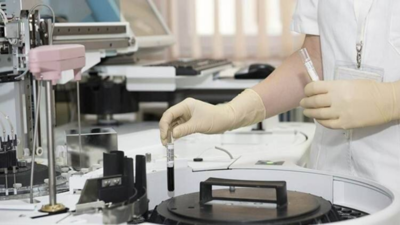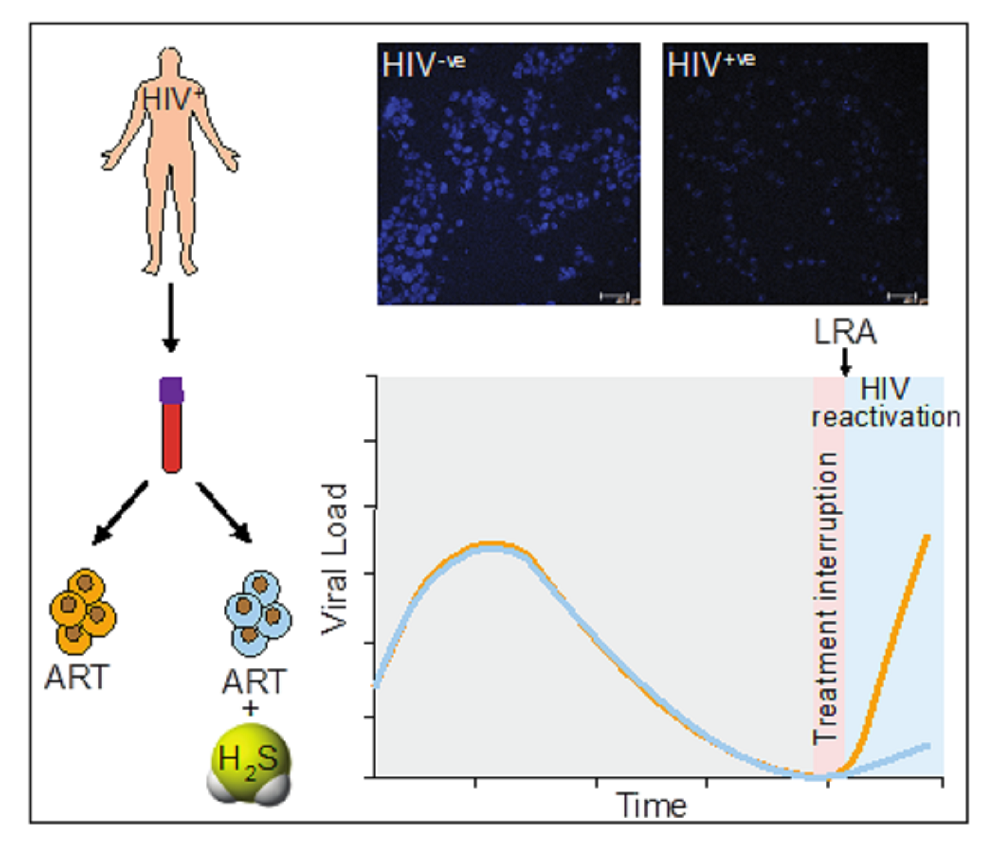Top Searches
- News
- India News
- IISc researchers show Hydrogen sulphide gas suppresses HIV infection

BENGALURU: Researchers from IISc and collaborators, have found that hydrogen sulphide (H2S) plays a key role in suppressing HIV as increased H2S gas has a direct effect on reducing the rate at which the virus multiplies in HIV-infected human immune cells.
The findings, researchers say, paves the way for developing a more comprehensive antiretroviral therapy against HIV. The team included researchers from the department of microbiology and cell biology (MCB) and the centre for infectious disease research (CIDR) at IISc and people from the Bangalore Medical College and Research Institute (BMCRI).
The results have been published in the journal eLife, IISc said in a statement. Pointing out that current state-of-the-art combined antiretroviral therapy (cART) is not a cure for HIV, researchers said, it can only suppress the virus – cause it to become latent.

“...Unfortunately, in some cases, cART is known to fail even when patients fully follow drug regimen. Certain negative effects are also associated with cART, such as the build-up of toxic molecules leading to ‘oxidative stress’ and loss of function in the mitochondria, the cell’s powerhouse. These effects can contribute to inflammation and organ damage. Stopping cART is also not an option because the virus can reactivate,” researchers said.
Amit Singh, associate professor, MCB/CIDR and corresponding author, said, scientists have recently begun exploring beneficial effects of H2S presence in HIV-infected cells on both oxidative stress and mitochondrial dysfunction. IISc added that in the previous study, Singh’s lab developed a tool to measure oxidative stress in cells infected with HIV.
“In that work, we showed that the chemical agent (N-acetylcysteine) could suppress HIV reactivation from latently infected cells. A German study later showed that N-acetylcysteine partly acts by releasing H2S molecules, which is when we began examining its role,” Singh said.
Previous work from Singh’s lab also looked at effects of counteracting oxidative stress by an antioxidant nanozyme during HIV infection. “Since H2S also functions as an antioxidant molecule, we wished to see whether our prior insights could be translated to show contributions of H2S on HIV infection,” Singh said.
Given that H2S’ role in HIV has not been explored before, researchers set experiments up from scratch. “Studying effects of a gaseous molecule on HIV required building and validating new model systems,” says Virender Kumar Pal, the first author of this study.
He said the team started with experiments on established cell lines before moving on to cells donated by HIV patients in 2019, adding that BMCRI collaborators and Prof Annapurna Vyakarnam’s group at CIDR were of great help.
“Detecting H2S inside cells was not a straightforward task. Since H2S cannot be detected using conventional biochemical techniques, we used colorimetric and fluorometric techniques,” he recalls.
Researchers studied effects of natural generation of H2S in HIV-infected cells and supplementing this with a chemical donor. “We observed H2S’ direct effect on suppressing HIV reactivation and replication along with all its other beneficial effects, such as maintenance of mitochondrial health and dissipation of oxidative stress in cellular models. Our results suggest maintenance of HIV latency and reactivation are closely linked to H2S levels in infected cells,” Singh said.
This, he added, opens the door to supplementing cART with chemical donors of H2S to lock HIV in a state of deep latency, potentially improving the lives of millions infected with the virus. “Since H2S donors are already undergoing clinical trials for other diseases, they can quickly be repurposed for HIV treatment,” he said.
The findings, researchers say, paves the way for developing a more comprehensive antiretroviral therapy against HIV. The team included researchers from the department of microbiology and cell biology (MCB) and the centre for infectious disease research (CIDR) at IISc and people from the Bangalore Medical College and Research Institute (BMCRI).
The results have been published in the journal eLife, IISc said in a statement. Pointing out that current state-of-the-art combined antiretroviral therapy (cART) is not a cure for HIV, researchers said, it can only suppress the virus – cause it to become latent.

“...Unfortunately, in some cases, cART is known to fail even when patients fully follow drug regimen. Certain negative effects are also associated with cART, such as the build-up of toxic molecules leading to ‘oxidative stress’ and loss of function in the mitochondria, the cell’s powerhouse. These effects can contribute to inflammation and organ damage. Stopping cART is also not an option because the virus can reactivate,” researchers said.
Amit Singh, associate professor, MCB/CIDR and corresponding author, said, scientists have recently begun exploring beneficial effects of H2S presence in HIV-infected cells on both oxidative stress and mitochondrial dysfunction. IISc added that in the previous study, Singh’s lab developed a tool to measure oxidative stress in cells infected with HIV.
“In that work, we showed that the chemical agent (N-acetylcysteine) could suppress HIV reactivation from latently infected cells. A German study later showed that N-acetylcysteine partly acts by releasing H2S molecules, which is when we began examining its role,” Singh said.
Previous work from Singh’s lab also looked at effects of counteracting oxidative stress by an antioxidant nanozyme during HIV infection. “Since H2S also functions as an antioxidant molecule, we wished to see whether our prior insights could be translated to show contributions of H2S on HIV infection,” Singh said.
Given that H2S’ role in HIV has not been explored before, researchers set experiments up from scratch. “Studying effects of a gaseous molecule on HIV required building and validating new model systems,” says Virender Kumar Pal, the first author of this study.
He said the team started with experiments on established cell lines before moving on to cells donated by HIV patients in 2019, adding that BMCRI collaborators and Prof Annapurna Vyakarnam’s group at CIDR were of great help.
“Detecting H2S inside cells was not a straightforward task. Since H2S cannot be detected using conventional biochemical techniques, we used colorimetric and fluorometric techniques,” he recalls.
Researchers studied effects of natural generation of H2S in HIV-infected cells and supplementing this with a chemical donor. “We observed H2S’ direct effect on suppressing HIV reactivation and replication along with all its other beneficial effects, such as maintenance of mitochondrial health and dissipation of oxidative stress in cellular models. Our results suggest maintenance of HIV latency and reactivation are closely linked to H2S levels in infected cells,” Singh said.
This, he added, opens the door to supplementing cART with chemical donors of H2S to lock HIV in a state of deep latency, potentially improving the lives of millions infected with the virus. “Since H2S donors are already undergoing clinical trials for other diseases, they can quickly be repurposed for HIV treatment,” he said.
FacebookTwitterLinkedinEMail
Start a Conversation
end of article
Quick Links
Coronavirus in MumbaiFarm bill 2020Farmers protestCoronavirus in DelhiCoronavirus in BangaloreCoronavirus symptomsCoronavirus in IndiaWest Bengal elections 2021Coronavirus NewsSolar EclipseNPRWhat is NRCCAB BillCAB and NRCAssam election 2021Podcast newsLok SabhaTamil Nadu Election 2021CongressBJP newsKerala Elections 2021Indian ArmyISRO newsSupreme Court

